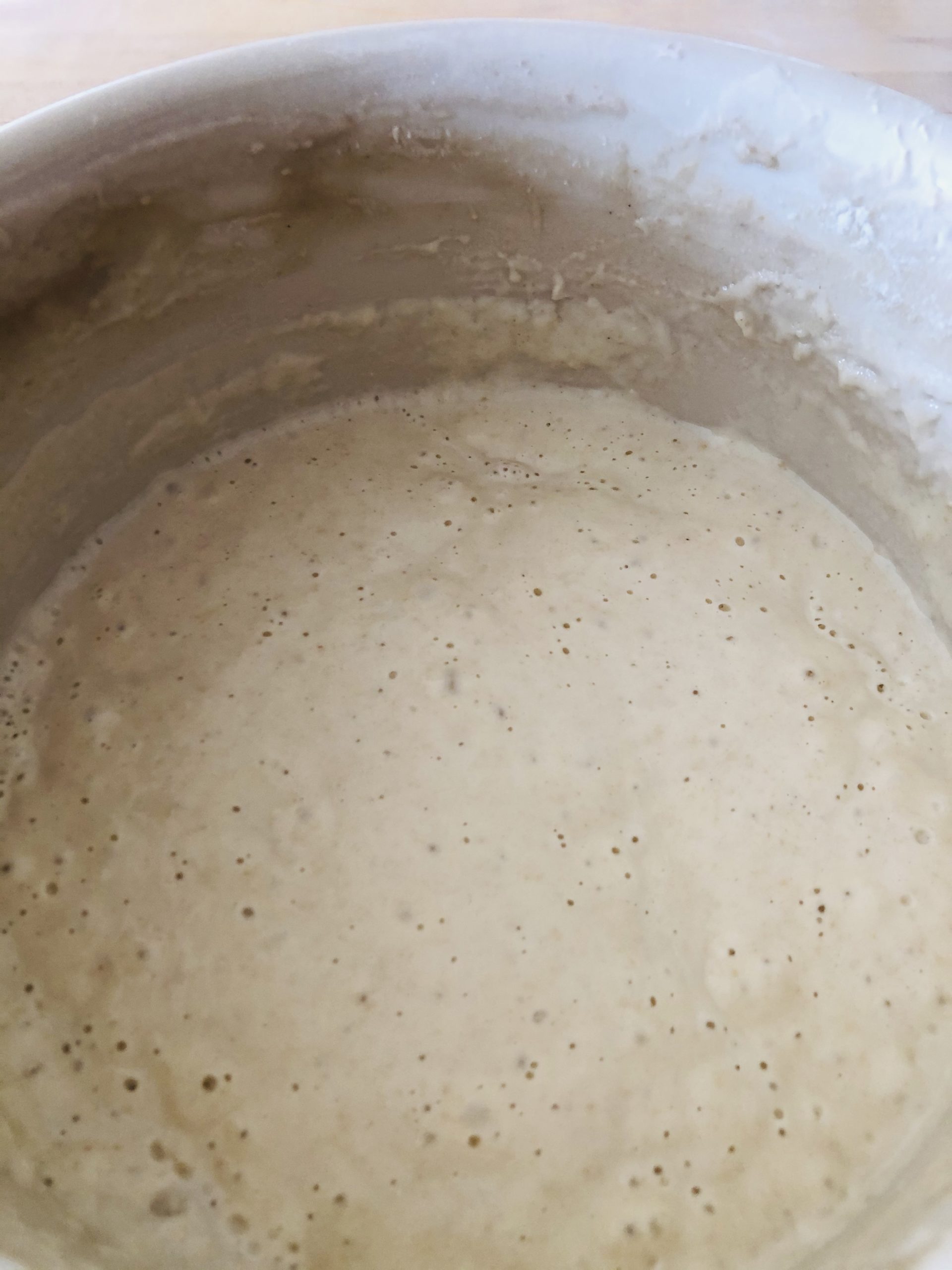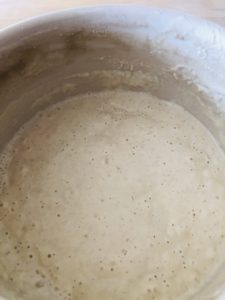Sourdough Starter
Why Sourdough Yeast?
Do you make your own sourdough artisan bread at home? Well, now’s the time to make this delicious artisan bread. The results you’ll get at home will be unbelievable. This bread is billowing with bubbles and chewy with a thick chestnut brown crust. Your local baker may not even be able to replicate this sourdough artisan bread like you.
If you don’t make a sourdough starter, it’s not too late to give it a try; it’s easy. If you don’t want to, that’s okay, just make my No-knead basic bread with the same results!
Learn why?
The Phytic acid found in wheat inhibits enzymes that are needed for the breakdown of proteins and starch in the stomach. It is this lack of enzymes that results in digestive difficulties. Ironically, commercially produced whole-grain bread, generally perceived as “healthy,” is often the worst thing a person with a wheat intolerance should eat.
The wild yeast lactobacillus in the sourdough leaven neutralises the phytic acid as the bread proves through the acidification of the dough. This prevents the effects of the phytic acid and makes the bread easier for us to digest. These phytic acid molecules bind with other minerals, such as calcium, magnesium, iron, and zinc, which makes these important nutrients unavailable to us. However, the good news is, a long, slow fermentation of wheat can reduce phytates by up to 90%.
There is an interesting study that compares the effects of different leavens (yeast, sourdough, and a mixture of both) on phytic acid degradation which assessed the repercussions of phytic acid breakdown on phosphorus and magnesium solubility during bread-making, that showed Sourdough fermentation was much more efficient than yeast fermentation in reducing the phytate content in whole wheat bread (-62 and -38%, respectively). The lactic acid bacteria present in sourdough enhanced acidification, which led to increased magnesium and phosphorus solubility.
Simply put, the phytase enzymes released by the yeasts as the dough acidifies effectively pre-digest the flour, which releases the micronutrients and in turn reduces bloating and digestive discomfort. Another benefit of sourdough is the prebiotic, which helps support the gut microbiome.
Did you gain knowledge? I suggest that if you love bread, you will take the time to make a sourdough starter for yourself!
How to Make a Starter!
Combine ½ cup flour and ½ cup filtered warm water at 90°F in a glass or plastic container. Make sure the container can hold about 2 quarts to avoid overflow.
Stir vigorously to incorporate air; cover with a breathable lid.
Leave in a warm place, 70-85°F, for 12-24 hours. Feeding every 12 hours will increase the rate at which your sourdough starter is multiplying its organisms; feeding every 24 hours will take a bit longer, but may be more sustainable depending on your time commitment.
At the 12 or 24-hour mark, you may begin to see some bubbles, indicating that organisms are present. Repeat the feeding with ½ cup warm water and ½ cup flour.
Stir vigorously, cover, and wait another 12-24 hours.
Repeat feedings every 12-24 hours by removing half of the starter before every feeding and discarding it. Feed with ½ cup warm water and ½ cup flour.
After about 5-7 days, the sourdough starter should have enough yeast and bacteria to be used for baking. Test the starter by filling a cup of warm water, taking a tablespoon of the yeast, and gently placing it on top of the water. If it sinks, the yeast is not ready to use. If it floats, you can use the yeast starter.
How to Maintain a Starter?
Feeding to maintain a sourdough starter involves combining flour and water to ensure the starter has the “food” it needs to stay healthy and active. Think of it like your child, as they grow, they require more food and water to be healthy. They also need air to breathe and a clean environment. (see feed your mother video) I don’t use the discard method for my sourdough. I keep it in the refrigerator and feed it 1 time per week.
If you bake frequently, I use a biga, which is an active starter kept at room temperature. If you don’t bake as often, the starter can be left in the refrigerator as I mentioned above. Make sure you bring it to room temperature and feed it before using. Once removed from the refrigerator, the starter can be used to prepare bread dough within 3-4 hours after being fed. Ensure the starter is at its peak of activity before using.
Keep in mind that some starters are naturally fast proofers, like a rye flour starter, so would require more frequent feedings.
When maintained at room temperature and fed daily, your sourdough starter will always be ready to use for baking. *Be sure to use unfed starter for your bread or prepare bread dough after 3-4 hours of being fed, to ensure the starter is at its peak of activity.
NOTE: A brown liquid layer on top of your starter, called hooch, indicates that the starter is hungry. If hooch forms, pour it off and feed the starter as soon as possible, then feed more frequently going forward.
How to Create a Thicker Starter
If pancake or waffles are a regular part of the morning meal, it may be helpful to maintain a slightly thicker starter. Feeding a starter should be like making bread dough, thick but mixed like a biga. From there, determine if more or less water at a feeding is desirable. See my stiff sourdough starter recipe.
Keep in mind that most recipes are developed with a 100% hydration sourdough starter, and so any deviation from that, especially for those recipes that do not use a sourdough starter, may produce a different final product.
Gluten Free Sourdough Starter you can find the recipe on Jovial Foods.


